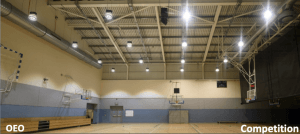How LEDs Can Reduce Glare in Your Business
By Leah • Aug 01, 2019
In the home glare is annoying. It obscures the TV and gets in your eyes at the dinner table. In industrial settings, it can be dangerous and cost you money. Reducing glare is tricky because you need to maintain brightness and not sacrifice light quality. LED might just be the solution to the problem of glare in your business.
What is Glare?
While we may know it when we see it, solving the problem of glare depends on knowing how it is caused. Glare is, essentially, an excess of light for the intended illumination purposes. We try to set an ambient light to fulfil the needs of a given space. Gauging this light can be a tricky process. As lighting needs are ever changing, we need to factor in many contingencies. Many industries err on the side of caution and make it brighter than they may need.
It isn't just caused by too much light. It is also caused by the angle at which light is directed at an object. If the light doesn't go in the right direction, it will reflect off certain surfaces and cause problems for workers.
Why is Glare a Problem?
If we work in an office, we need enough light to see documents, navigate desk layouts and other important practical matters. The same goes for large industrial spaces such as warehouses and factories.
If we have too much light, however, it can complicate practical tasks. It can make reading instructions more difficult which affects productivity. In sports halls, it can make play more difficult for the players, just as much as if the light is insufficient. Forklift drivers need to be precise, meaning too much glare can contribute to safety hazards.
One of the most important problems is that too much light causes light pollution. Like all pollution, this can have a negative impact on the human body. It leads to stress, exacerbates mental health issues and can even cause headaches. This affects a worker's sleep patterns, which in turn affects safety, productivity and the well-being of the worker.
Is Natural Light Better for Glare?
While natural light is generally better for the human body's circadian rhythm (although not necessarily for our skin), it is not always ideal in industrial environments. The amount of natural light is not controllable. Clouds, time of day and bad weather can mean we either have not enough light or too much glare. This is one of the reasons many industrial spaces do not have many windows to allow in natural light.
How Can LEDs Reduce Glare?
LED light is much more controllable than rival lighting technologies. High intensity discharge lights such as metal halide and high pressure sodium lamps work in a way which creates 360° of light. The arc light can be reflected, but it cannot be controlled. More than this, although they can be dimmed, they can only provide light on one spectrum at a time.
LED lights create a bright white light which is much more controllable. They use much less light energy to create a brighter light source. This not only provides savings, but it can reduce glare. LEDs do so by providing a bright light with a controllable color temperature. Blue light can cause more glare, but phosphor coatings on LED bulbs control the amount of blue light emitted.
More importantly, however, LEDs can be designed differently to arc-light bulbs such as HIDs. This is even, or especially, the case with high-bay industrial settings. Lens angles and controlled light emissions mean the bulbs shine the light where it is needed without creating needless glare.
The better design of the bulb, the better we can control glare. This is evidenced by the OEO EZ LED SUPER HYBRID 20K. The special batwing optics of this bulb are designed to reduce glare and deliver previously wasted lumens to their intended target. If you have a glare issue in your business (or you simply want to save money), contact usfor an ROI analysis and make a positive change.
